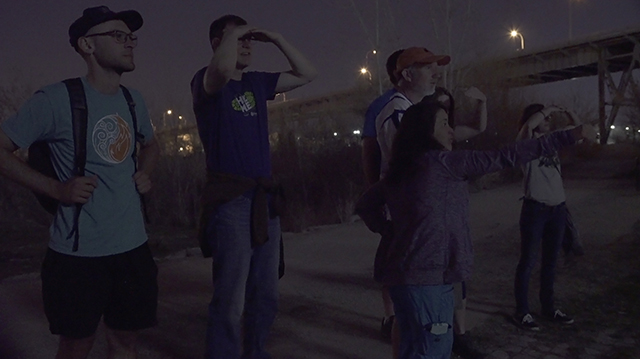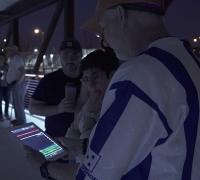Acoustic bat monitoring occurs after sunset when bats are most active. Community scientists walk specific routes while carrying monitoring equipment which translates the high-frequency echolocation calls bats use to search for prey and avoid obstacles into visual sonograms. So far this year we’ve conducted three of these bat walk surveys.
With so few surveys, how is it possible that acoustic bat monitoring is such a big part of our spring and summer research?

UEC’s bat monitoring research goes way beyond the greenspaces around each branch. In addition to walking surveys, the Community Science team also manages one of only a few long-term bat monitoring stations in the entire state of Wisconsin. Permanently housed at Riverside Park this station collects data 365 days a year.
As southeastern Wisconsin regional coordinators for the Wisconsin Department of Natural Resources’ Wisconsin Bat Program our monitoring efforts are multiplied when community scientists trained at UEC borrow equipment to monitor additional neighborhood greenspaces including multi-county driving routes. This includes partnering with numerous area nature centers that borrow the equipment to engage their own communities in bat research.
And that’s only bat monitoring on land! Community scientists also and visit regional waterways to monitor bats by kayak, where so far in 2018 they have surveyed the Milwaukee River, Rock River, Long Lake, Lake Beulah, Bark River, and Como Lake.
And the project goes beyond data collection. Because the acoustic bat monitoring equipment translates echolocation sound wave data into visual sonograms of each bat species’ unique calls, we are able to share our findings with the Wisconsin Department of Natural Resources for identification. Community Scientists have been working to better understand the data we collect in the field—and explore new ways of connecting the community with the identification process, from dichotomous keys to the possibilities of computer applications to identify bat calls and discover trends. Together with partners like Menomonee Valley’s Escuela Verde high school, we’ve also conducted experiments with multiple versions of bat monitoring equipment to better understand the compatibilities and limitations of new monitoring technologies.
This spring the Urban Ecology Center’s Research and Community Science team co-hosted University of Wisconsin-Stevens Point mammologist Dr. Chris Yahnke who spent a semester-long sabbatical analyzing our bat data and exploring new ways to connect the community to bat research. Dr. Yahnke partnered with numerous local schools and organizations to create hands-on STEAM (Science, Technology, Engineering, Arts, and Mathematics) learning opportunities for students to explore real-world data, uncover results, and connect to local conservation efforts.
Why has there been so much community interest to get involved in this research?
Bats are gaining national attention as important insectivores that protect crops, gardens, and forests from insect pests and reduce economic and public health costs of pesticide application. But these ecosystem services are vulnerable as cave-hibernating bats are threatened by White Nose Syndrome, a deadly fungal disease that causes them to expel energy reserves. This is in addition to threats of habitat loss, pesticide application, and wind turbines.
Learn more about the importance of Wisconsin’s bats and conservation efforts in The Bats of Wisconsin, a narrated bat presentation by project partner and Milwaukee County Zoo’s Kara DeLanty.
Community-based partnerships are at the heart of Wisconsin’s bat research where natural resources managers, professional scientists, students, and community members work together to create a truly collaborative research project—from data collection and analysis to using science to conserve these species. It is community science at its best.
We invite you to be a part of all the Urban Ecology Center’s 300+ field research surveys and strive to get data off of the clipboard to be used by researchers and community members to better understand urban wildlife and ecosystem restoration progress. Summer bat monitoring will take place in late July at each of the Urban Ecology Center branches.
Join us to learn more and participate in this important research.







